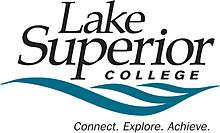Lake Superior College
 | |
| Motto | Connect. Explore. Achieve. |
|---|---|
| Type | Two-Year Community and Technical College |
| Established | 1995 |
| President | Dr. Patrick Johns |
| Students | 5,800 |
| Location | Duluth, MN, United States |
| Campus |
Main, 97 acres (39 ha) and Gary/New Duluth, 105 acres (42 ha) |
| Mascot | Ice Hawks |
| Affiliations | Minnesota State Colleges and Universities |
| Website | lsc.edu |
Lake Superior College (LSC) is a two-year community and technical college in Duluth, Minnesota.
The college offers pre-baccalaureate majors for students interested in transferring to 4-year educational institutions as well as more than 90 certificate, diploma and degree programs in career and technical fields. LSC's Continuing Education/Customized Training division collaborates with area businesses and industry to design specialized opportunities for entry-level and advanced education. While courses are typically offered in traditional classroom and lab settings, LSC also offers over 150 courses via the internet, through its e-campus. In recent semesters, more than 25% of credits have been delivered online and a growing number of programs are offered completely online. These include dialysis patient care, accountant, business administration, computer and web programming and an Associate in Arts transfer degree.
History
Lake Superior College was created when the Duluth Technical College and Duluth Community College Center (which was technically the Duluth campus of Hibbing Community College) merged in 1995. At the time, Duluth Community College was housed in a wing of The Marshall School, and Duluth Technical College was housed in LSC's current location. The community college programs were relocated on to the former Technical School campus, when it was expanded in 1996.
Facilities

Built in 1968, LSC's main campus is located at 2101 Trinity Road in Duluth on a 97-acre (39 ha) tract that overlooks the western portion of the Duluth/Superior harbor and the Saint Louis River. The campus features an award-winning hiking trail, a trout stream (Miller Creek) and access to a city-run disc golf course. Facilities have been expanded and upgraded over the years. For example, in 2007 when the Academic and Student Services building was completed and an area of the campus was renovated to house a Student Life Center.
On March 14, 2010, legislation approving funding for a new Health and Sciences Center addition was signed into law.[1] The $12 million plus project broke ground June 11, 2010 and a grand opening was held on Friday, January 6, 2012. The building opened for classes on Monday, January 9.
In addition to its main campus, LSC also operates an Emergency Response Training Center on 105 acres (42 ha) in Gary/New Duluth and a Professional Pilot Training Center out of leased facilities at the Duluth International Airport.
Lake Superior College opened a Duluth Downtown Center in August 2014 to house welding, computer-aided drafting, and machining programs. This move increased the amount of teaching space in these fields from 3,000 square feet to 33,700 square feet and included new equipment for labs.
In September 2016, LSC opened a new Center for Advanced Aviation in Hangar 103 at the Duluth International Airport. LSC's aviation programs— professional pilot and aviation maintenance technician- are now under one roof. This 40,000-square-foot facility was remodeled to serve FAA teaching requirements.
Accreditation
Lake Superior College is accredited by the Higher Learning Commission of the North Central Association of Colleges and Schools.
Recognition

In 2008 and 2009, Lake Superior College was ranked among the nation’s most technically advanced community colleges, according to an annual survey conducted by the Center for Digital Education and Converge magazine, LSC was ranked tenth in 2008 and seventh in 2009 among the medium-sized community colleges (3,000 – 7,500 students) in the annual Digital Community Colleges Survey.[2][3] The survey identifies and spotlights colleges that provide a high level of service to their students and faculty through information technology.
Leadership
The president of Lake Superior College is Dr. Patrick Johns. He began his assignment on July 1, 2010, succeeding Dr. Kathleen Nelson, who had served as president for 13 years. Johns had previously served as president of Anoka-Ramsey Community College in Coon Rapids and Cambridge, Minnesota. LSC's first president was Harold Erickson. He served from 1995 to 1997.
Sustainability
Lake Superior College President Dr. Kathleen Nelson signed the American College and University Presidents’ Climate Commitment at a ceremony on Tuesday, September 30, 2008, joining more than 550 colleges that have pledged to create campuses that lead by example on environmental issues.
Leadership in Energy and Environmental Design or LEED is an internationally recognized green building certification system, focused on improving energy savings, water efficiency, CO2 emissions reduction, indoor environmental quality, stewardship of resources and other environmental metrics. In 2010, Lake Superior College’s Academic and Student Services “S” building has become the first LEED certified building in the Minnesota State Colleges and Universities (MnSCU) system.[4]
Governance
Lake Superior College is a member of the Minnesota State Colleges and Universities System.
Lake Superior College is immune to "Educational Malpractice" lawsuits.[5]
Notes
- ↑ http://blog.lsc.edu/wave/2010/03/15/governor-pawlenty-approves-funding-for-lake-superior-college-health-and-sciences-center/
- ↑ http://www.convergemag.com/awards/digital-community-colleges/Digital-Community-Colleges-Survey-Winners-2009.html
- ↑ http://www.convergemag.com/awards/digital-community-colleges/2008-Digital-Community-Colleges-Survey.html
- ↑ http://www.businessnorth.com/pr.asp?RID=3404
- ↑ No Private Right of Action… refer to the 1999 Minnesota Court of Appeals decision in Alsides v. Brown.
External links
Coordinates: 46°47′03″N 92°08′41″W / 46.7841417°N 92.1448306°W